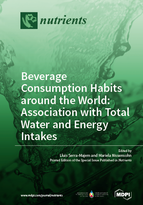Beverage Consumption Habits around the World: Association with Total Water and Energy Intakes
A special issue of Nutrients (ISSN 2072-6643).
Deadline for manuscript submissions: closed (31 July 2016) | Viewed by 162717
Special Issue Editors
2. Research Institute of Biomedical and Health Sciences (IUIBS), University of Las Palmas de Gran Canaria, 35001 Las Palmas, Spain
3. Preventive Medicine Service, Centro Hospitalario Universitario Insular Materno Infantil (CHUIMI), Canarian Health Service, 35016 Las Palmas, Spain
Interests: mediterranean diet; public health; nutrition; obesity; epidemiology; diet; macro and micronutrients; hydration
Special Issues, Collections and Topics in MDPI journals
Interests: hydration; mediterranean diet; public health; nutrition; obesity; epidemiology; diet; macro and micronutrients
Special Issue Information
Dear Colleagues,
Fluid intake has barely been assessed, and hydration status has only rarely been measured in epidemiological studies. This hampers attempts to assess the adequacy of water intake at a population level. However, although guidelines have been established to determine how much water humans require to avoid dehydration and to optimize physical and psychological function, limited data are available on the total water and beverages intake. Therefore, the percentage of population with inadequate water intake is unknown. There is a clear need for studies in different settings around the world that quantify total water and beverage intake and explore associations between types of beverages consumed and energy intake.
The objective of this proposed Special Issue is to publish papers detailing the analyses of nutritional databases regarding the consumption of adequate amounts of total water. It is important to obtain information about how beverage consumption varies with age, gender, the day of the week, and time of day, and how this is related to total water intake.
Also, if it is possible, we welcome an evaluation of the association between socio-economical level and beverages consumed, and an analysis of whether the variety of beverages consumed is a positive predictor of total water intake. Furthermore, we would be interested in analyses as to how much and in what proportion the energy from beverages contributes to dietary patterns, if they exist, in the countries around the world.
It is very important to know the diversity of methodology used in the quantitative assessment of beverages consumption, the seasonal variability and all the details that the results of the studies show.
The key idea is to accomplish, through this special issue, a picture of the real water intake in the world in relation to the current guidelines in order to promote adequate fluid consumption in humans.
Dr. Lluis Serra-Majem
Dr. Mariela Nissensohn
Guest Editors
Manuscript Submission Information
Manuscripts should be submitted online at www.mdpi.com by registering and logging in to this website. Once you are registered, click here to go to the submission form. Manuscripts can be submitted until the deadline. All submissions that pass pre-check are peer-reviewed. Accepted papers will be published continuously in the journal (as soon as accepted) and will be listed together on the special issue website. Research articles, review articles as well as short communications are invited. For planned papers, a title and short abstract (about 100 words) can be sent to the Editorial Office for announcement on this website.
Submitted manuscripts should not have been published previously, nor be under consideration for publication elsewhere (except conference proceedings papers). All manuscripts are thoroughly refereed through a single-blind peer-review process. A guide for authors and other relevant information for submission of manuscripts is available on the Instructions for Authors page. Nutrients is an international peer-reviewed open access semimonthly journal published by MDPI.
Please visit the Instructions for Authors page before submitting a manuscript. The Article Processing Charge (APC) for publication in this open access journal is 2900 CHF (Swiss Francs). Submitted papers should be well formatted and use good English. Authors may use MDPI's English editing service prior to publication or during author revisions.
Keywords
- Total water intake
- Energy Intake
- Beverages consumption
- Water intake
- Adults, Infants (population)
- Adequate hydration








